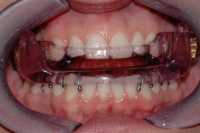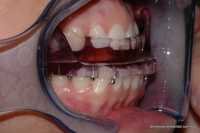Simple Snoring Without Apnoea
SIMPLE or BENIGN SNORING WITHOUT OBSTRUCTIVE SLEEP APNOEA (OSA)
Dr Deutsch has a special interest in the dental treatment of Simple Snoring and Sleep Apnoea and is a member of the Australian Sleep Association.
Dr Deutsch is very experienced in fitting mandibular advancement splints for treating both simple snoring and snoring with obstructive sleep apnoea and is a Gold Status SomnoMed Dental Sleep Professional as recognised by the Somnomed company.
SIMPLE or BENIGN SNORING
Simple or Benign Snoring (Snoring without Obstructive Sleep Apnoea) by itself does not cause significant medical problems as there is adequate flow of oxygen to the body organs.
Loud snoring may cause significant embarrassment and problems with partners sleeping in the same room.
During normal breathing, air passes through the nose, over the soft palate, uvula, tongue and the muscles and soft tissues of the throat. The airway is kept open by the tone of the muscles around the airway. When awake in an upright position the neck musculature tends to move the structures of the neck away from the airway. During sleep the muscles and soft tissues around the airway may relax too much. Lying down, especially if sleeping on your back, makes the structures in the neck fall backwards onto the airway and restricts the air that can pass into the lungs. Snoring is caused by the soft tissues associated with the airway vibrating against each other, especially in the region where the soft palate meets the tongue. In more severe cases partial or complete collapse of the airway may take place below the level of the tongue.
OBSTRUCTIVE SLEEP APNOEA (OSA)
OSA is caused by partial or complete obstruction of the airway resulting in a partial or complete stop in breathing resulting in little or no oxygen going to the brain and body organs.
MIMMICKED SNORE TEST
Prior to starting treatment, a mimicked snore tests can be performed to determine if a Mandibular Advancement Splint will be completley or partially successful in eliminating or greatly buy tramadol ultram online reducing snoring .
Unfortunately there is a small percentage of people who will not be suitable for a mandibular advancement splint.
The mimicked snore test gives a good indicator whether a MAS will be successful for reducing snoring.
It is not possible to determine clinically which patients have benign snoring from those patients with both snoring and sleep apnoea.
The Epworth Sleepiness Scale gives an indication as to whether someone has sleep apnoea. Sleep apnoea is associated with excessive daytime sleepiness and patients suffering sleep apneoa usually score above 10 on the Epworth Sleepiness Scale.
The only definitive way to determine whether someone has sleep apnoea is to have a Sleep Study and assessment of the results by a sleep physician.
(See webpages on Sleep Apneoa and Sleep Study for further information.)
The American Academy of Sleep Medicine (Westchester IL) recommends oral appliances be used for benign snoring without obstructive sleep apnoea.
Treatment is available for simple snoring using a especially constructed oral appliance called a Mandibular Advancement Splint (MAS).
HOW DO MANDIBUALR ADVANCEMENT SPLINTS WORK ?
The MAS positions the jaw forward at about two thirds of the maximum forward movement of the lower jaw and opens the bite about five millimetres. As the tongue is attached to the lower jaw, any forward movement of the lower jaw moves the tongue forwards and away from the back of the throat and soft palate thereby opening up the airway. The muscles and soft tissues attached to the tongue and lower jaw in the neck region also move forward and away from the airway.
These devices must be worn every night during sleep to be effective.
95% of suitable people will have reduced snoring sounds and will have a marked decrease both in volume and frequency of snoring.
TYPES OF APPLIANCES
There are many different types of appliances available on the market.
A mandibular advancement splint should be tailored to the patient’s individual problems by a dentist experienced in making these devices.


